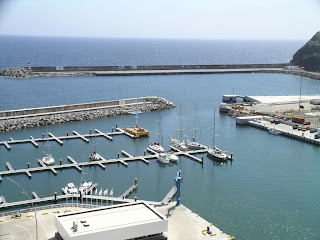 The Passage to Aςores.
The Passage to Aςores.After rushing about making the final preparations, we finally left Portimao in the early afternoon of May 18, hoping that the 750nm passage to Ponta Delgado would take between 6 and 7 days. Along the coast of the Algarve the wind was very light and variable, with an annoying swell. However,as daylight faded and we approached Cabo San Vicente, the wind rapidly piped up to over 20 knots from the North and we soon had 3 reefs in. We had delayed the evening meal too long, so that we ended up with everything happening at once—darkness, reefing and eating. For Sue this would turn out to be the only meal of the trip!
The next day and a half passed uneventfully, making good progress on a beam reach in a Northerly Force 4-5. For a while we picked up a couple of hitchhikers, in the form of a couple of little birds who explored the boat thoroughly before flying off. Sue wasn’t well enough to get out of her bunk, so it was a bit tiring for me being on watch the whole time, although I did manage to snatch enough sleep to get by. The shipping was pretty heavy initially but thinned out quite a bit, as we made our way west. I was very thankful for the AIS to help me assess the ships around us.
The morning of the second full day at sea turned out to be a defining moment for the trip. I went to start the generator as normal to replenish the batteries after the night but absolutely nothing happened. Eventually I spotted that everytime I pressed the preheat switch, a relay on the generator tripped out. This had happened once before when in harbour but on that occasion, just resetting the relay fixed things. Now, it seemed permanent though, so it looked as if we would have to rely on the engine for charging, which was less than ideal. Even less ideal was the fact that when I started the engine, the starter motor failed to disengage—the same problem as had lead to us buring out the previous starter motor earlier in the year. This time we spotted the problem quickly and realized that it was caused by the key not returning to its proper position after starting, so it was easily fixed. The engine was now running but we didn’t know whether we had damaged the starter motor, so we were faced with a dilemma. Should we turn the motor off once the batteries were charged and take the risk that we couldn’t get it started again or play for safety and leave it running. We chose the safe but noisy option and left it running for the next 100 hours!
A little after this we suffered the final setback of the trip, when the forecasts started showing the weather to be becoming rather unfavourable. A depression moving out from between Portugal and N Africa in a few days time was going to pinch the isobars together, increasing the wind but more significantly changing the direction into the NW. The best tactics for us appeared to be to stay on a beam reach on starboard tack and let the backing wind carry us down to the South. For once, things played out just as planned. By the early hours of 23 May , the wind had backed and freshened to Force 6-7 and instead of heading straight for Ponta Delgado on Sao Miguel, our course was taking us halfway between Santa Maria and Madeira! However, the condition weren’t too unpleasant, as we had very little in the way of rain and a fair amount of sunshine. By then end of May 24, the wind had started to moderate and veer back a little. With it forecast to go back into the North but very light, it made sense to change our destination to Santa Maria, so we could turn the engine off as soon as possible! At first light on 25 May we tacked and with a little help from the engine, were shaping a reasonable course towards Santa Maria.
By midday we had more typical Azorean weather with a glassy calm sea and were glad of the mechanical horse. The dead calm didn’t last too long and then we had gentle Force 2-3 until, at sunset, I sighted the island 30 miles to the North. The pilot book advised against a first time night entry into the harbour of Vila do Porto, so we sailed very gently onwards until we about 10 miles off, then waited for dawn. There was no other traffic about, so this gave me the opportunity to catch up on some much-needed sleep. Eventually the sun rose behind the island, heralding a beautiful morning and all the tribulations of the voyage were forgotten. At 9am we were safely secured in the marina where, in spite of the hour, I celebrated with a cold beer. The marina is only 2 years old and people don’t seem to have discovered it yet, so it was almost empty. There were just 6 yachts when we arrived but no other British ones among them. In the best Azorean tradition, the staff were very friendly and helpful, with no language problems, so we could soon settle back to recover from the voyage. Instead of 6-7 days, it had taken almost 8 days and we had ended up at a different island from that originally intended but we had made it in one piece!!